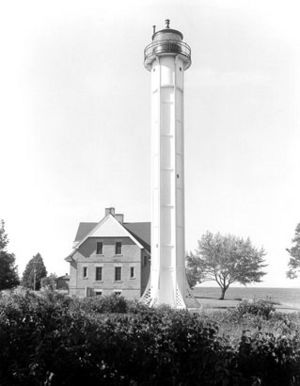St. Martin Island Light facts for kids
 |
|
| St. Martin Island Light USCG Archive | |
|
|
|
| Location | St. Martin Island Lake Michigan |
|---|---|
| Coordinates | 45°30′10″N 86°45′27″W / 45.50278°N 86.75750°W |
| Year first constructed | 1905 |
| Year first lit | 1905 |
| Foundation | Granite |
| Construction | Steel exoskeleton |
| Markings / pattern | white with black lantern |
| Height | 75 ft (23 m) |
| Focal height | 81 feet (25 m) |
| Original lens | occulting 4th Order Fresnel illuminated by a 24,000 candlepower incandescent oil vapor lamp. Rotating red and white flash panels. |
| Current lens | 7.5-inch (190 mm) Tideland Signal acrylic lens |
| Range | 18 nautical miles (33 km; 21 mi) |
| Characteristic | Al W R 10s: W fl 5s ec.; R fl 5s ec. Light visible from 135° to 355°, dark sector covering island. |
| ARLHS number | USA-802 |
| USCG number | 7-21450 |
The St. Martin Island Light is a special lighthouse located on St. Martin Island in Lake Michigan. It helps guide ships through one of the four main passages between Lake Michigan and the bay of Green Bay. Built in 1905, this light tower is unique. It is the only one of its kind in the United States with an "exoskeleton" design on the Great Lakes.
Contents
About St. Martin Island Light
This lighthouse stands tall, painted white with a black top. It is shaped like a hexagon. The tower is made of strong iron plates. These plates are held up by six steel posts on the outside. These posts have a criss-cross pattern for extra support.
What Makes It Special?
The St. Martin Island Light is known as an "exoskeleton" lighthouse. This means its main support structure is on the outside, like a skeleton. This design is very rare in the United States. It is the only pure exoskeleton tower on the Great Lakes. Similar designs can be found in Canada.
The Keeper's House
Next to the lighthouse is the lightkeeper's house. This is where the person who operated the light used to live. The house was built with a special type of brick called "cream city brick." Its design was similar to the houses used for the Plum Island Range Lights.
Fog Signals and Sounds
Lighthouses often have fog signals to help ships when it's foggy. The St. Martin Island Light originally had a steam fog signal. This made a loud sound to warn ships. Later, this steam signal was replaced with a different type called a diaphone. A diaphone also makes a loud sound, but it uses compressed air.
A Historic Landmark
The St. Martin Island Light is an important historical site. It was added to the National Register of Historic Places on July 19, 1984. This means it is recognized as a place worthy of protection. It is also considered a Michigan State Historic Site.
Visiting the Lighthouse
Today, the St. Martin Island Light station is closed to the public. The lighthouse keeper's dwelling, or house, is no longer used and needs a lot of care. The lighthouse is managed in partnership with the Little Traverse Bay Band of the Odawa Indian Nation.


